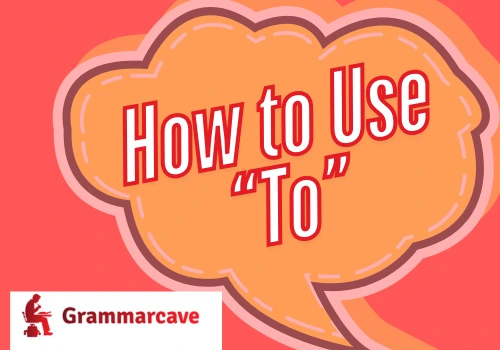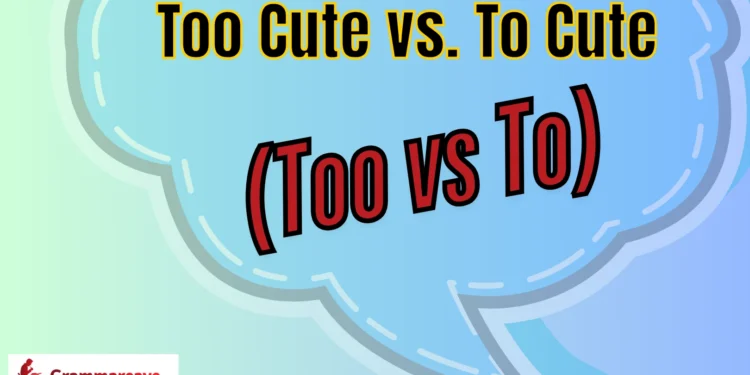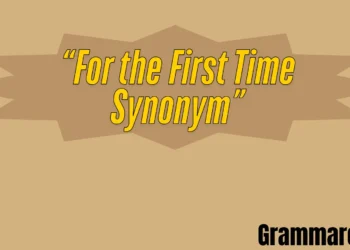English difficulties can lead to tricky mistakes. One example is dealing with homophones, such as too vs To.” Though they are spoken in the same way, these are two words with meanings and grammar functions that don’t have anything in common. Mixing them up can cause problems in oral and written communication.
“To” is usually used as a preposition and thus shows the path, the place of arrival, or the purpose of the action. Also, it serves as a part of an infinitive verb, such as, “I’m going to the store.” At the same time, “too” is an adverb of excess. It can be synonymous with “also,” or it can show that something is carried out beyond the limits—as in: “That puppy is too cute.”
The confusion between the two is frequent, but a clear insight into their tasks makes them much easier to avoid. I have always encouraged my speaking skills with examples most of the time in my practical English lessons, an essential learning tool. For instance, in the sentence ”I want to eat,” the word to as part of an infinitive verb is used, while in the case of the sentence “This dessert is too sweet,” the word to is used to express excess. I usually ask myself… Would this word lead to a direction, aim, or a verb? If so, it’s likely to. Is it adding intensity or meaning “also”? Then it’s probably too.
I’ve found it helpful to associate it with movement, purpose, intensity, or inclusion. This simple mental shortcut has made my communication more accurate and confident.
After all, getting the hang of it is also a lot about context and practice. Observing the willingness of every word to function in the very instances and the language of regular people acts as your best source of learning how to do it this way. Mastering just one language is difficult. However, the situation with English is that understanding the correct use of to and to is proper grammar and a necessary condition for clear and compelling self-expression, whether you are fluent in the language or just starting to learn it.
Too vs To: What’s the Difference?
To the ear, “to” and “too” sound the same; however, in reality, they are two different words playing different parts of the sentence, so if a wrong word is used, the meaning will completely change.
“Too” is an adverb used to mean “in addition,” it also tells us when someone or something has crossed the line or the limit. For instance, we use “too” as in
“I’ll go to the mall too.” (meaning also the same).
“That puppy is too cute.” (meaning the way it is, it is extreme or incredible).
On the other hand, “to” is a preposition that indicates a target or gives the reason for the action, or it is used to create the base form of a verb. The following examples illustrate its function:
“Let’s go to the mall.” (direction)
“I want to eat.” (infinitive verb)
Too Cute vs. To Cute: What’s the Difference?
If you ask for the difference between “too cute” and “too cute,” you will be interested in aspects of grammar and use.
“Too cute” is correct. Here, too, means overly cute.
For example: “The puppy rotary is cute!! !”
“To cute” is incorrect. There is an adjective cute < (color)-card that makes the phrase sound improper and confusing.
The confusion arises from the fact that to and too are homophones — they sound alike but have different functions.
- Use too when expressing excess or inclusion (also).
- Use it when showing direction, movement, or forming an infinitive.
How to Use “To”
The preposition “to” is predominantly used to denote the object’s direction, manner, and cause as the attribute of change. A typical example is “I am going to the store,” the direction is what it depicts. As another example, “to” is the main requirement for constructing the infinitive verbs, e.g. “I want to eat.”
Also, “to” implies that the thing not directly connected with the speaker initially but is now so is described correctly, e.g., “This book belongs to me.” The element also talks about ranges or periods, such as “It will take five to ten minutes.”

Being able to distinguish between “to” and “too” by being aware of the hymn of the multiple functions in various contexts is a must for any writer, translator, sentence changer, or, speaking in general, thinker. The significant implications for the people who want to be informed first by the “too”, as a degree are present or secondly, when it represents the meaning “in addition to,” or even “further” see the above. In the same way, the category “too” is synonymous with the category “the”; in coordination, the former permits the use of parallelism. See, it tends to take, as an object, something closed.
How to Use “Too”
“Too” is an adverb used to show excessiveness, emphasis, or to mean “also.”
- “That puppy is too cute,” where “too” expresses extreme cuteness.
- “I want to go too,” where “too” means “as well” or “also.”
- “That was too good!” where “too” intensifies the compliment.
When using “too,” it’s helpful to compare it with words like “also” or “very” to ensure it fits the tone and intention of your sentence.
Examples of “To” (Preposition or Infinitive):
- He walked to the train station before sunrise. (direction)
- I need to call my sister this evening. (infinitive verb)
- The letter was addressed to her old apartment. (destination)
- We went to a concert downtown last night. (place)
- She promised to help me with the assignment. (intended action)
Examples of “Too” (Adverb of Excess or Addition)
- This suitcase is too heavy to carry alone. (excessiveness)
- The baby cried too loudly during the flight. (intensity)
- I was too nervous to speak in front of the crowd. (overwhelmed feeling)
- That dress is too expensive for my budget. (excessive cost)
- He wants to join the club too. (also/in addition)
Key Differences Between “Too Cute” and “To Cute”
This is how it goes: “Too Cute” is so excessively cute or friggin charming, while “To Cute” just makes no grammatical sense and has no real meaning.
You know, like when you saw a baby smile for the first time and said “too cute.” It does not make proper sense this way, sentence-wise!!}
Too cute is a term often used in casual dialogue or social media to explain an emotional reaction. On the other hand, has it ever entered an English dictionary that “to cute” means to verbify?
It’s ‘too cute’ if anything comes off as sweeter or more endearing than it should be. But “to cute” would be confusing and doesn’t mean anything.
“Too cute” is a response of joy or admiration that escalates to emotional overwhelm due to an excessive level of charm—best suited for puppies (in this case), toddlers, and sweet gestures.
You might describe a child’s drawing or a small animal’s behavior as “too cute” to bear. “To cute” is an incorrect word placement that, as such, makes it a communication obstacle.
Most people tend to say “too cute” when they want to reflect affection, joy, or a light and funny reaction. In contrast, “to cute” is deprived of emotional overtones because it cannot support them structurally or semantically.
Whether in the written or spoken mode “too cute” works quite favorably to infuse the content with a friendly and enthusiastic atmosphere. “To cute” will mostly be considered a spelling or grammatical error.
The right way to express an overload of charm is to use “too cute,” whether we are talking about a playful moment, a small outfit, or a sweet animal.
“To cute” should be avoided as it has no meaningful use.

Examples of “Too Cute” in Sentences
- That toddler in the bunny costume is too cute for words!
- The way she wrote me a note in crayon was just too cute.
- His clumsy dance moves were too cute to ignore.
- The kitten curled up in a teacup is honestly too cute.
- Their friendship bracelets are matching—too cute!
- The puppy tried to howl like an adult dog—it was too cute!
- That tiny hat on the hamster? Just too cute to handle.
- Her handmade card was crooked but too cute and heartfelt.
- The twins in matching pajamas are too cute to describe.
- He gave me a rock he found because it “looked lucky”—too cute!
Meaning of Too Cute too cute (English)
The expression “too cute” denotes a level of cuteness or charm that is so great it becomes almost cloying. It implies that the cuteness goes above and beyond what is necessary or appropriate—often evoking a visceral response.
How are “Too” and To Different in the Phrases Too Cute vs. To Cute?
Too is an adverb that shows excess or a high degree—i.e., “too cute” means exceptionally adorable.
But “To” is a preposition that depicts motion in the direction of something or place, like I’m going to store.
The use of “to” in the phrase “to cute,” on the other hand, is incorrect grammatically since it does not fit with how we would want to structure/mean what this sentence represents.
FAQs
How Can I Easily Remember When To Use Too Cute Instead of Too Cute It is helpful to ask, “Am I writing too cute?
If so, ” TOO” is the right word. It’s also related to other terms that reflect excess like too much, too loud or even “too fast.” These snippets help consolidate the members, when, and how they use too.
Are there any instances ‘To Cute’ is Appropriate to use in a Sentence?
“To cute” is not grammatically correct and should be avoided. The term we are looking for is “too cute” because it explicitly states that the cuteness goes beyond normal amounts or levels.
How much more confusion would there be when saying “to cute” instead of too?
The substitution of “to cute” for “too cute” is ambiguous in that it does not fit into standard grammar, and there are many ways to interpret what this could mean. It seems awkward to the reader or listener, unnatural, and leaves them wanting more somewhere.
Conclusion
“Too cute” means something is excessively adorable—so charming that it feels almost overwhelming—whereas “to cute” isn’t grammatically correct in this context. Using the extra “o” signals that sense of going beyond—like “too hot,” “too sweet,” or “too loud”. Remember: if you mean very or excessively, use “too cute”; if you write “too cute,” it will appear as a typo, not a valid expression. In short, “too cute” shows a lovable overload, while “to cute” is wrong. Keeping that extra “o” ensures your writing feels polished—and lets you confidently share heartfelt delight.








